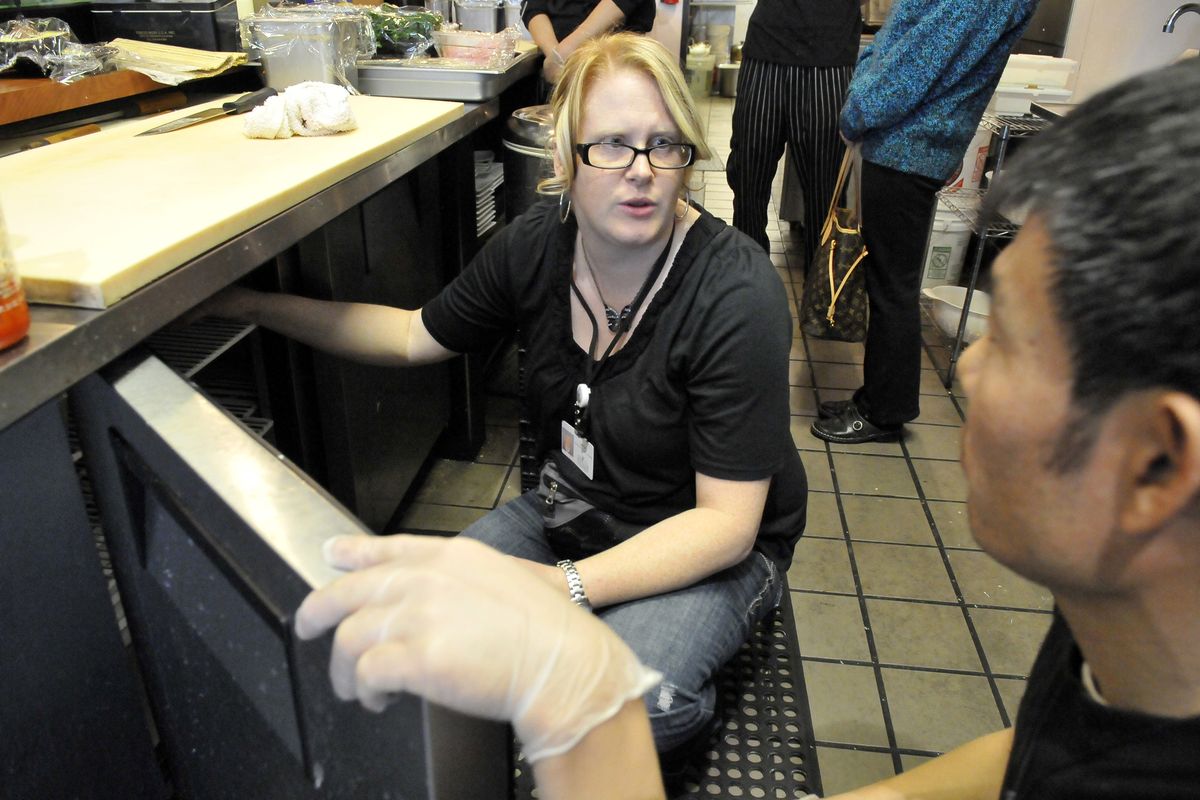Budget cuts have public health agencies slashing staff, services
Vikki Barthels pokes a thermometer into fresh fish to check the temperature in the cold case at Sushi I on the South Hill.
The steady erosion of public health funding and services in Washington has spurred a statewide review of how shrinking agencies can adapt to meet the growing needs of communities with fewer dollars.
“Almost unbelievably, unless we change course, for the first time since statistics started to be kept, today’s youngest generation may not live as long as their parents,” Washington’s health secretary, Mary Selecky, wrote in a report asking public health officials statewide to find ways to prioritize and address health issues with less money.
The agencies that investigate and protect against disease, inspect restaurants, test drinking water, conduct sting operations to curb tobacco sales to teens, promote cancer screenings and fight obesity are having to eliminate other popular programs – often those that provide specialized help for individuals.
Spokane health officials insist they are preserving the heart of public health services even as they eliminate programs that help families and children with specialized health needs.
In the past eight years, the Spokane Regional Health District has cut more than 40 jobs. That’s nearly 20 percent of its staff as funding levels dip to the lowest levels in a decade, said Administrator Torney Smith.
Many of the public health issues are similar in North Idaho.
The Panhandle Health District now has 115 employees – down from 143 a few years ago. They oversee everything from septic and sewer system inspections and permits to restaurant inspections and HIV/AIDS education and prevention. They’re being asked to carry out their work as funding declines, said Director Lora Whalen.
This past week, for example, Spokane’s health district reduced its budget by $2 million. It didn’t get there by whittling away at excess administration or asking every department to find savings.
This time, Health Officer Dr. Joel McCullough and his staff used a complex computer program to help them analyze and ultimately rank the importance of programs within the scope of public health mandates, community expectations and money.
The health district next year will be left with about 200 staff and diminished resources – not helping, for example, the parents of babies born with cleft lip and palate navigate complicated medical advice and care. And it will scale back its programs that help children with hearing loss and other special needs that can interfere with learning and social development.
Mothers such as Lindsay Perez are upset.
Her baby was born with cleft lip and palate and although she is a registered nurse, she was baffled at times about the specialized care required, and even struggled with feeding.
A public health nurse responded to her pleas for help.
“I was on the verge of taking my baby back to the hospital,” she said during emotional testimony to the Board of Health, urging them to keep such individual programs.
“We don’t like what we’ve had to do. It’s terrible,” said McCullough, the soft-spoken leader hired in 2009.
His first duties in Spokane were taken right from the annals of classic public health.
With H1N1 influenza – commonly called swine flu – sickening and killing people across the country, McCullough and his staff hurried to develop a public information campaign that drew in schools, businesses, volunteer organizations and medical providers. Together they sought to temper fears even as thousands of ill people in Spokane and surrounding communities jammed hospitals and vaccine supplies lagged.
Once the vaccines arrived, the health district launched an immunization effort that included free shots to thousands of people – many who stood in lines stretching for blocks.
Food, water safety a priority
Public health most often plays a less noticeable role.
As the lunch crowd thinned at Sushi I on South Regal Street one day last week, Vikki Barthels checked the restaurant for cleanliness and the food for safety.
On any given day, nine food safety inspectors fan out across Spokane County conducting surprise visits to about 2,300 businesses that serve food. They include burger joints and swanky restaurants, grocery stores, service stations and espresso stands.
“If they sell food to the public, we inspect it,” said Jon Sherve, food program technical adviser with the health district. He ensures that the inspections are consistent and adhere to health codes designed to lessen the risk of food poisoning.
The Centers for Disease Control and Prevention estimates that about 48 million Americans get sick each year from eating tainted food. About 128,000 are hospitalized; some 3,000 die.
Among the worst cases include this year’s listeria outbreak from eating contaminated cantaloupes from a Colorado farm. The CDC said 13 people died and 72 were sickened in 18 states. None was from Washington, Idaho or Oregon.
Selecky, Washington’s health secretary, said food and water safety must remain a core mission of public health, along with the disease prevention and emergency preparedness.
She asked public health officials from across the state to devise an “Agenda for Change,” a blueprint for prioritizing public health responsibilities and how to fulfill the mission with smaller budgets. The report is a guide for health agencies wrestling with what programs to keep and what programs to cut.
“We are at a crossroads,” Selecky said.
Despite gains, challenges remain
Public health gains from years past have been significant: fewer smokers, better vaccines, widespread water fluoridation, use of seat belts, access to contraception and safer workplaces. They helped extend the life expectancy of Americans from 49 years to 80 years in the past 100 years.
Yet the upcoming challenges are daunting.
Chronic yet preventable diseases such as diabetes and heart disease, Selecky said, are on the rise due to obesity and its accomplices – poor nutrition and sedentary lifestyles.
Efforts to protect the public from the spread of disease spans centuries. Selecky noted that modern efforts were inspired by the work of English physician John Snow. In 1854, he investigated and helped stop a deadly cholera outbreak in London.
Snow discovered that many deaths were clustered in an area where people drew water from a pump along the city’s Broad Street. His work resulted in the pump being disabled. It’s a classic example of using statistics and epidemiology to unravel a public health mystery to save lives, Selecky said.
Today there’s a memorial to Snow at the place where the pump brought tainted water to people.
Such protective programs and investigations at the center of public health’s mission were on display earlier this year in Spokane when investigators, working closely with specialists at Providence Sacred Heart Medical Center, identified the source of Legionella bacteria in part of the hospital’s water supply that had infected several people.
Under the direction of public health investigators, the system was flushed with a chlorine solution.
While investigating and stopping disease outbreaks will always be a focus, Selecky worries about the prevention side. In particular she zeroes in on fading emphasis against tobacco.
Although cigarettes have been demonized as killers and smokers have been kicked out of public buildings, Selecky said easing the anti-tobacco campaign may unravel years of hard-fought success that is saving lives and dollars.
“We can show a 5-to-1 return” on anti-smoking programs, she said. “For every $1 spent on helping people quit, that’s $5 not spent on health care issues like asthma, emphysema and heart disease.”
And yet the Washington Legislature has withheld funding.
“We can’t even fund the Quit Line,” Selecky said. “We’re the only state in the nation not funding a quit line for uninsured individuals trying to go smoke free.”
David Crump, chairman of Spokane’s health board, called the cuts to specialized medical care programs a sad example of how public health has had to retreat from programs that help individuals to preserve its broader mission of protecting the greater community.
Borrowing a quote, Crump said on the verge of his difficult vote: “I believe a measure of society is how it cares for the most vulnerable of its citizens.”

